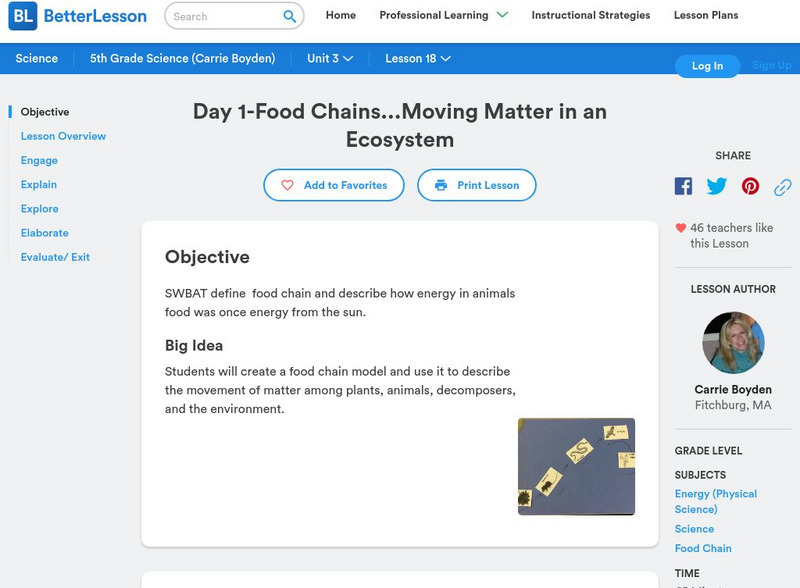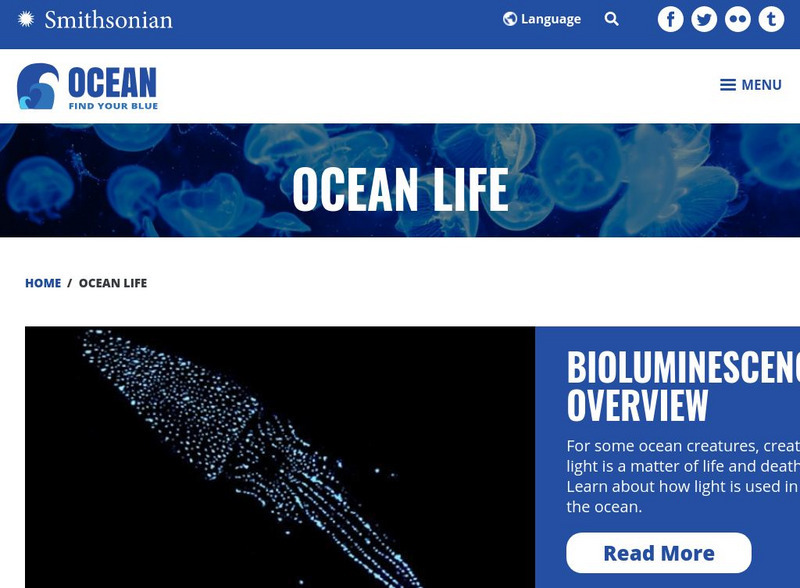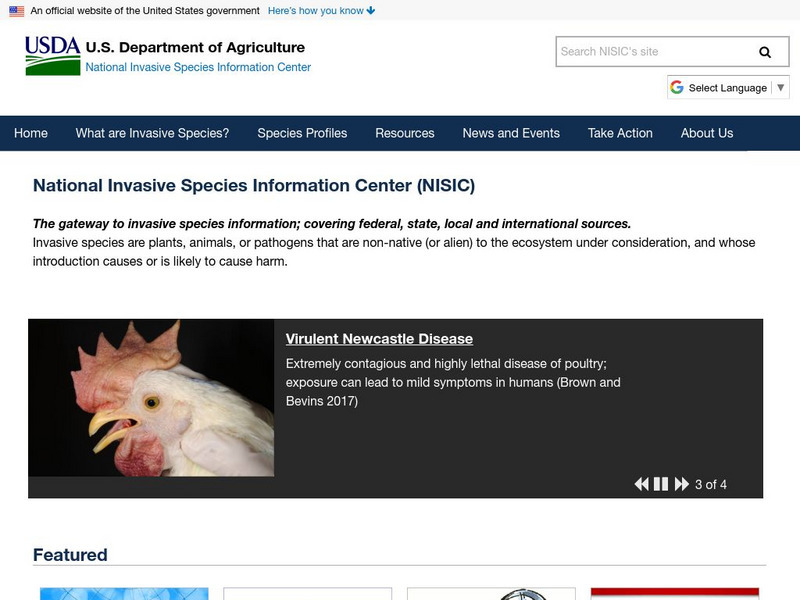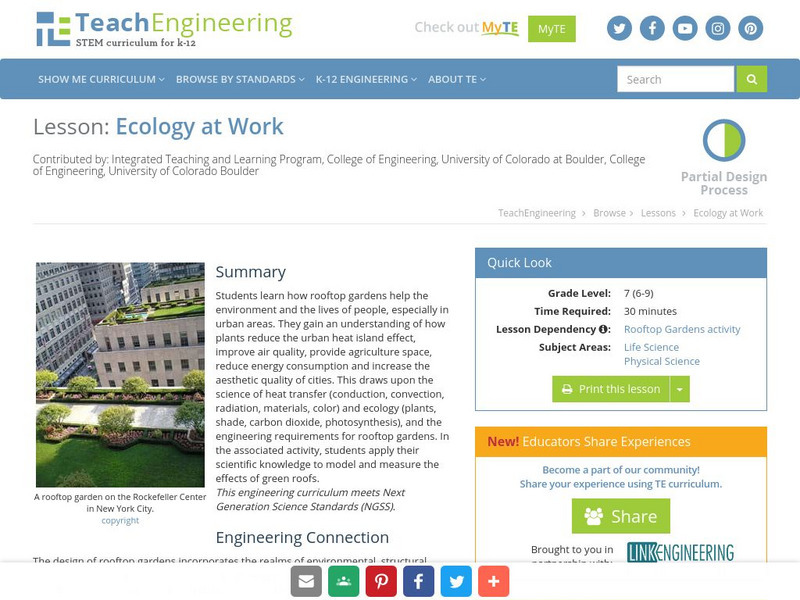Hi, what do you want to do?
Better Lesson
Better Lesson: Food Chains Moving Matter in an Ecosystem (Day 1)
Students will create a food chain model and use it to describe the movement of matter among plants, animals, decomposers, and the environment. Resources include a detailed lesson plan, student handouts, pictures of a completed chain,...
NOAA
Noaa: Chesapeake Bay Interpretive Buoy System: Data in the Classroom
NOAA Smart Buoys collect and transmit real-time weather, water conditions, and water quality data. Chesapeake Exploration gives teachers and their students unprecedented access to lessons designed around real-time observational data from...
Other
Living Lakes: Saint Lucia Lake
Provides color pictures and statistics on the biological and watershed characteristics of the Saint Lucia Lake on the east coast of South Africa.
Smithsonian Institution
National Museum of Natural History: Ocean Portal: Ocean Life & Ecosystems
From the tiny to the titanic, from the familiar to the undiscovered, the ocean offers a stunning diversity of marine life and nearly every kind of habitat imaginable. Dive in and explore them here. Links incude stories, videos and photos...
Other
Insectclopedia: Lesson Plans
A very comprehensive site from pedagonet.com that includes lesson plans on insects for all ages and grade levels. Students will enjoy learning about insects as you employ these engaging lesson plans in your own classroom.
Other
Department of Agriculture: National Invasive Species Information Center (Nisic)
A comprehensive guide to national invasive species, including alien plants, animals, and microbes. An invasive species is one that is likely to cause environmental or human harm.
The Franklin Institute
Treasures@sea: Exploring the Ocean Through Literature
This extensive resource consists of learning activities that integrate language arts with oceanography. Each activity is based on one of seven books about the ocean and are written to be adaptable. Includes writing activities, games and...
Utah Education Network
Uen: Nhmu: Living Food Web
Fourth graders will be able to name some plants and animals that live in Utah's desert, forest or wetland ecosystems.
Utah Education Network
Uen: Trb 4:5 Investigation 9 Bird Study
Learn about specific bird characteristics and become more aware of the ecosystems that support each bird.
Utah Education Network
Uen: Animals in the Ecosystems
Write about animal contributions to their environment.
Texas A&M University
Insects in the Classroom: Lesson Plans
A very comprehensive site that includes insect lesson plans for ages 3-18 and links to a syllabus, course material, activities, and related resources.
PBS
Pbs Learning Media: Sharks in Our Future
In this video segment from Nature, see the value that sharks can have on the tourism industry in an area. [1:41]
Utah Education Network
Uen: Human Settlement and Geography
Learn why people live in places with lots of people.
Utah Education Network
Uen: Introduction to Habitat Alteration
Introduction to the concepts of habitat and habitat change.
Utah Education Network
Uen: Themepark: Home/habitat: Habitat
Find a large collection of internet resources organized around habitats. Links to places to go, people to see, things to do, teacher resources, and bibliographies.
American Museum of Natural History
American Museum of Natural History: What Is Water?
This comprehensive article provides information about the physical properties of water, the importance of water as an Earth material, the processes and cycles that water undergoes on Earth, its importance to life on Earth, and why we...
BSCS Science Learning
Bscs: Frog Symphony
This inquiry focuses on analyzing spatial and temporal data for frog calls to determine the best time of day and location to hear a symphony of frogs. Click on the link for teaching guides and handouts.
BSCS Science Learning
Bscs: Restoring Ea Middle School Science Unit
Restoring Ea is a place-based middle school science unit exploring management strategies that could be used for the Loko ea fishpond to sustainably feed people and ensure the ecosystem is healthy and pono (balanced). While specifically...
TeachEngineering
Teach Engineering: Ecology at Work
Students learn how rooftop gardens help the environment and the lives of people, especially in urban areas. They gain an understanding of how plants reduce the urban heat island effect, improve air quality, provide agriculture space,...
Khan Academy
Khan Academy: Activity: The Voyage of the Beagle
In this activity, you'll learn how to interpret images and maps in order to extract information about Darwin's trip to the Galapagos Islands. Links provided for a gallery of images and a worksheet.
PBS
Pbs Learning Media: Dinosaur Train
Dinosaur Train sparks children's interest in life science and natural history. As they explore a variety of animals, children develop the inquiry skills and knowledge needed to help them think, talk and act like paleontologists. Choose...
McGill University
Mc Gill University: Canadian Biodiversity: Ecozones: Southern Arctic
A brief, concise description of the Southern Arctic ecozone which extends across the northern edge of the continental Northwest Territories and Quebec. It includes a collection of images of the landscape as well as those of animals and...
McGill University
Mc Gill University: Canadian Biodiversity: Ecozones: Taiga Plains
The Taiga Plans are centered around the Mackenzie River in the western Northwest Territories. This is a brief, concise description of the location, climate, geology and flora and fauna. It includes a collection of images of the landscape...
McGill University
Mc Gill University: Canadian Biodiversity: Ecozones: Taiga Shield
This ecozone stretches eastward from the Taiga Plains to just south of the Southern Arctic. This brief, concise description includes a collection of images of the animals and birds native to the location. Many of the images include...
















